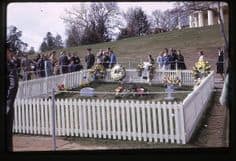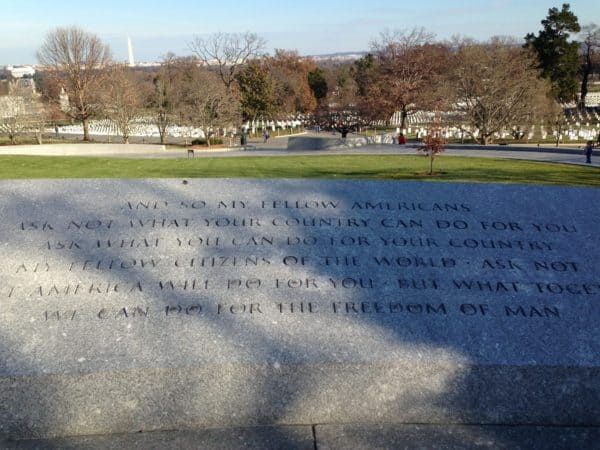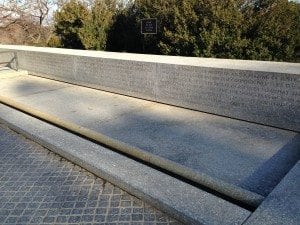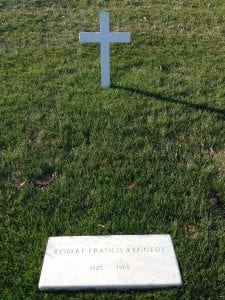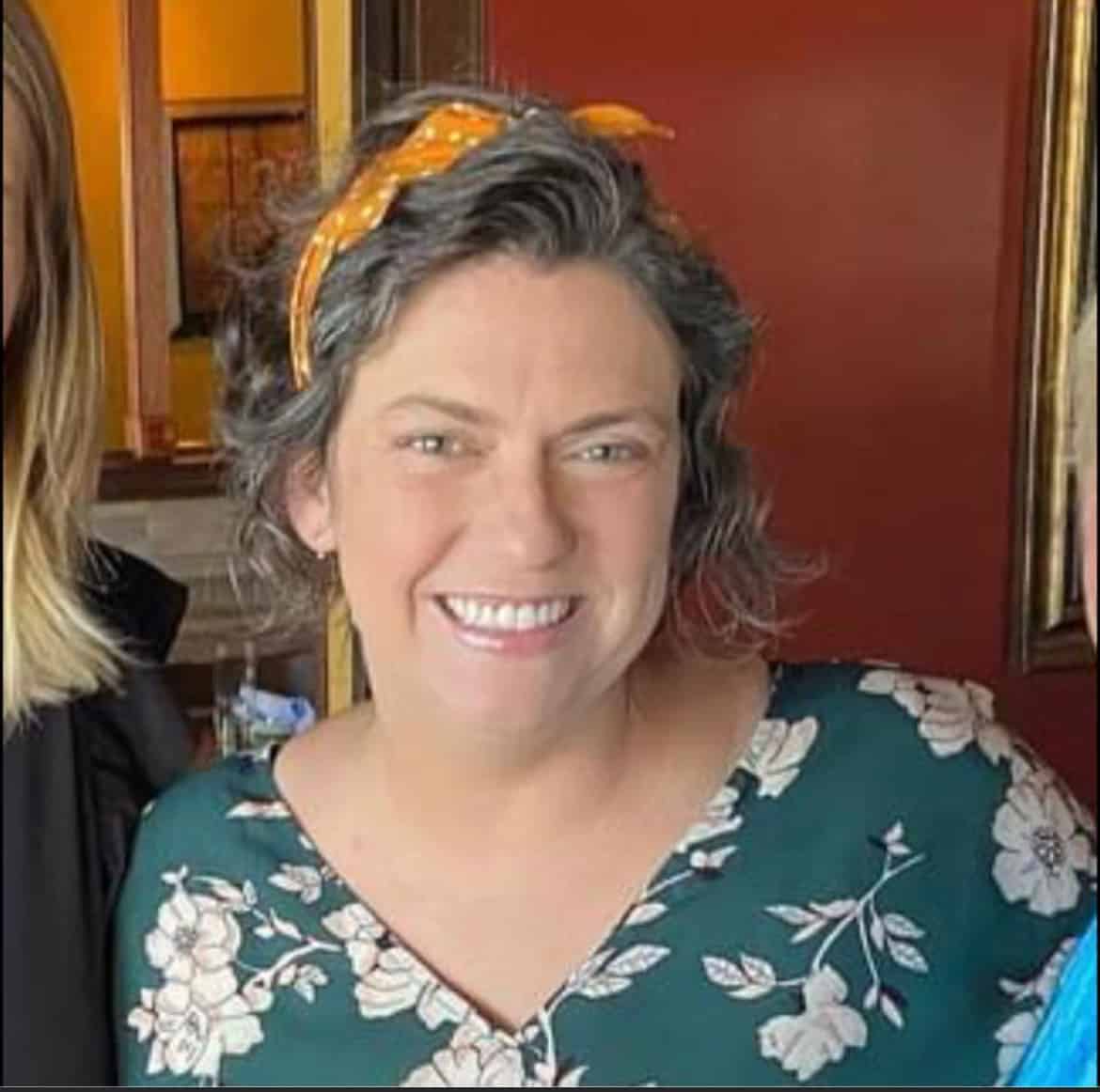President John F. Kennedy is buried in Arlington National Cemetery in Arlington, Virginia.
In this post, we will explain why he is buried here, and how you can visit his gravesite, and explain the design of this memorial to the 35th President of the USA.
Additionally, you can all visit the gravesites of his wife, 2 children, as well as brothers Robert F. Kennedy, Teddy Kennedy, and Joe Jr.
Why is JFK Buried in Arlington National Cemetery?
On a visit to Arlington National Cemetery in March of 1963, just 8 months before his assassination, President Kennedy paid a visit to Arlington House, which had been recently renamed the Robert E. Lee National Memorial.
The president was a big history buff and he relished the chance to walk in the same room where General Lee had decided to resign from the army that he had served for 30 years.
Upon leaving the house, Kennedy soaked up the spectacular view of the cemetery as well as the capital city, purportedly stating, "I could spend forever here."
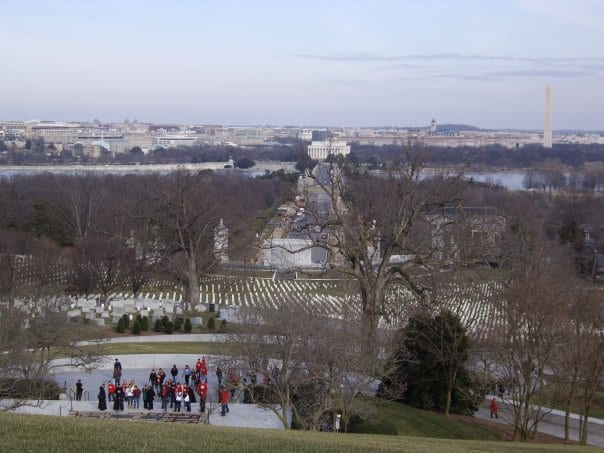
Immediately following his assassination, there were many questions as to where he would be buried.
Many people assumed he would be buried in his home state of Massachusetts as most presidents are buried in their home states, if not their home towns.
However, when asked, his wife Jacqueline, who was informed of her husband's words, stated, "he belongs to the people."
She realized that the public was in mourning and that a small private cemetery could not sustain the number of visitors who would want to visit President Kennedy's grave.
She thus requested that her husband be laid to rest at Arlington National Cemetery.
The Original Memorial
On November 25, 1963, President Kennedy's funeral commenced.
The ceremony was modeled after the service rendered for President Lincoln, also per the request of Mrs. Kennedy.
A space on the hillside below Arlington House was chosen as the burial plot by the President's younger brother and Attorney General, Robert Kennedy, and then later confirmed by Mrs. Kennedy.
The area overlooks Memorial Bridge and offers an incredible view of Washington, DC.
In honor of his legacy, an eternal flame was lit at the gravesite by Mrs. Kennedy.
Mrs. Kennedy was absolutely correct in her prediction of the public's desire to visit the President's grave.
Within the first 3 years, over 16 million people came to pay their respects.
Though the initial memorial involved just a simple grave marker, the eternal flame, and a white wooden fence, the vast number of visitors necessitated the erection of a larger memorial.
The Eternal Flame - John F. Kennedy Memorial
The current design, created by a family friend and architect John Carl Warnecke, was to be simple.
It was to be a "grave marked by a memorial, as opposed to a memorial marked by a grave" in contrast to the more ostentatious memorials throughout the nation's capital.
There were two overriding design considerations.
The Eternal Flame
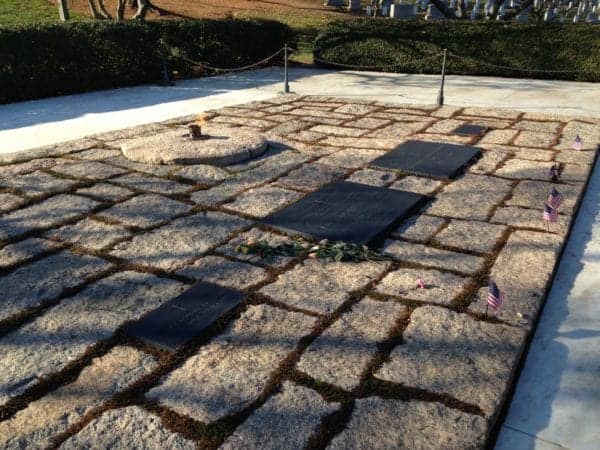
First, the memorial and grave would have to reflect early New England burial traditions, comprised of a simple granite headstone set flat in the ground surrounded by grass.
According to the Kennedy Library, the grave area also consists of irregular granite stones quarried near the Kennedy family home in Cape Cod.
Fescue and clover can be seen in the crevices between the stones to aid in the appearance that the stones are lying in a Massachusetts field.
Additionally, both the granite and marble you will walk on when you visit were quarried in New England.
Second, the design was to take into account Kennedy's faith in God. The new design incorporated the eternal flame from the first memorial.
Excerpts from the President's first inaugural address (including the famous quote, "ask not what your country can do for you, ask what you can do for your country" were engraved around the elliptical, and an elevated rectangle terrace was constructed to accommodate the graves.
President Kennedy's two deceased children. The first is Patrick Kennedy, who died in infancy a few months prior to the assassination.
The second child is Arabella Kennedy, whose grave marker simply reads "Daughter" as she was stillborn and did not receive a birth certificate or an official name.
His wife, Jacqueline Kennedy, was interred after her death in 1994.
Mrs. Kennedy came up with the idea of an eternal flame after having seen one memorializing the Tomb of the Unknown Soldier under the Arc de Triomphe in Paris.
WHERE IS THE GRAVESITE?
The tomb and memorial to President John Fitzgerald Kennedy are located in lot 45, Section 30 of Arlington National Cemetery (ANC).
It is a 10-minute walk from the Visitor Center (map) and a 15-minute walk from the Arlington Cemetery Metro Station.

You will not be able to drive to the gravesite. Walking is how the majority of visitors reach it.
However, the site is one of 3 stops on the trams that operate in the cemetery. Tickets for the trams can be purchased inside of the Visitor Center.
Please note that you will be walking up a slight incline to reach the site. The site is wheelchair accessible.
At the gravesite, absolute silence is expected. Men are also expected to take off hats.
Robert "Bobby" Kennedy Memorial
If you are facing the memorial wall with Washington, DC viewable in the distance at JFK's gravesite, you will need to exit to your right
On June 6, 1968, less than 5 years after his brother's assassination and just a few months after the assassination of Dr. Martin Luther King Jr., Robert Kennedy was killed after giving a speech in Los Angeles.
At the time, he was the leading Democratic nominee for the presidency and was serving as Senator from New York.
Again, there was question as to where he should be buried, but ultimately it was decided to lay Senator Kennedy to rest next to his brother.
A funeral Mass was held at St. Patrick's Cathedral in New York City, then his remains were transported on a train to Washington, D.C.
Thousands lined the train tracks to pay their respects, delaying the train's arrival into Union Station until 9:10 p.m.
A quiet and beautiful ceremony featuring 1,500 candles, Senator Kennedy's funeral at Arlington National Cemetery is the only one to take place at night.
Three years after the initial burial, a more elaborate memorial was constructed in honor of Senator Kennedy.
The memorial features a semi-circular plaza, similar to the one featured in the president's memorial.
On the hill side, stands a simple, white wooden Christian cross. At the time of RFK's funeral, this was the only white, wooden cross in ANC.
Opposite the cross, is a long, low-lying wall with shallow, calm waters with two inscriptions.
The first inscription is an excerpt taken from a speech given to students in South Africa in 1966 championing the anti-apartheid cause:
"It is from numberless diverse acts of courage and belief that human history is shaped each time a man stands up for an ideal or acts to improve the lot of others or strikes out against injustice. He sends forth a tiny ripple of hope, and crossing each other from a million different centers of energy and daring, those ripples build a current that can sweep down the mightiest wall of oppression and resistance."
Possibly by design, small bubble peculate every few minutes from the back right causing small ripples waves to pass by the readers eyes.
The second quote comes from an except taken from a speech RFK delivered in Indianapolis on the night of Martin Luther King Jr's assassination.
"Aeschylus...wrote, "Even in our sleep, pain which cannot forget falls drop by drop upon the heart, until, in our own despair, against our will, comes wisdom through the awful grace of God.' What we need in the United States is not division; what we need in the United States is not hatred; what we need in the United States is not violence and lawlessness; but is love and wisdom, and compassion toward one another, and a feeling of justice toward those who still suffer within our country, whether they be white or whether they be black."
That evening and for several days following it, there was unrest in many cities across the USA. Indianapolis was not one of them.
Edward "Ted" Kennedy Memorial
If facing Washington, D.C., continue down the path to your right to visit Edward Kennedy's grave.
Edward Kennedy, the youngest of the Kennedy brothers, passed away in 2009 after serving as Senator from Massachusetts for nearly 47 years.
Known as the "liberal lion of the Senate," Ted Kennedy tragically lost his battle with brain cancer after 17 months.
Following his death, Senator Kennedy's body was transported to Boston where it lay in repose at John F. Kennedy Library.
Tens of thousands of visitors came to pay their respects to the veteran senator.
A funeral mass was later held at Our Lady of Perpetual Help Basilica in Roxbury, MA.
It was attended by many politicians, foreign dignitaries, and celebrities; President Obama delivered the eulogy.
Senator Kennedy was then transported to Washington, DC, and a motorcade proceeded toward the Capitol before continuing on to Arlington National Cemetery.
Due to his 2 years of service in the United States Army combined with his time as senator, Ted Kennedy qualified to be buried at Arlington National Cemetery.
He was laid to rest on the same slope as his brothers, just 100 feet from Robert Kennedy.
His grave is marked with the same glossy white oak cross as Robert Kennedy, their's being the only two white wooden crosses in the cemetery.
Senator Kennedy was a frequent visitor at Arlington National Cemetery, attending half a dozen times a year to visit his brothers and other loved ones.
In 2012, a more elaborate pathway was added to the gravesite, connecting Senator Ted Kennedy's grave with those of his older brothers.
Joseph P. Kennedy Jr.
Continue down the same pathway to the right to visit Joseph P. Kennedy Jr.'s grave.
When the new pathway was added for Ted Kennedy's grave in 2012, a memorial headstone was dedicated in honor of Joseph P. Kennedy Jr., who was the eldest of the Kennedy brothers.
Prior to his death, Joseph Kennedy was very much predicted to be the leader and politician in the family.
As the first born son of Joe Kennedy Sr., the U.S. Ambassador to the United Kingdom, Joseph Kennedy Jr. was encouraged to pursue politics after his service in the military.
However, he was tragically killed in a top secret mission during World War II. Due to his bravery and sacrifice, Joseph P. Kennedy was awarded the Navy Cross, Distinguished Flying Cross, Purple Heart, and Air Medal.
Following Joseph's death, John F. Kennedy, the second eldest of the Kennedy brothers, went on to fulfill those roles of leadership.
Unfortunately Joseph P. Kennedy Jr.'s remains were never recovered. However, in 2012 a cenotaph was erected in his honor.
Related Content:






